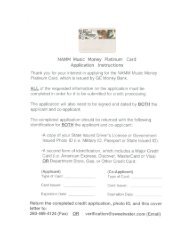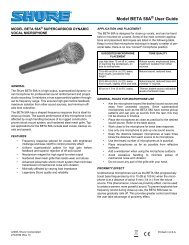Create successful ePaper yourself
Turn your PDF publications into a flip-book with our unique Google optimized e-Paper software.
Keyboard Mode Functions<br />
Viewing or Editing the Favorite List<br />
If you press FAVORITE [ON/OFF] and [ENTER] simultaneously,<br />
the Favorite list for the currently selected bank will appear.<br />
Button<br />
Operation<br />
Parameter Explanation Value<br />
Preset<br />
Equal<br />
Equal Tuning: This tuning divides<br />
the octave into 12 equal parts,<br />
and is the most widely used<br />
method of temperament used in<br />
Western music.<br />
Press<br />
[ENTER]<br />
VALUE dial<br />
Selects the Favorite number to be edited.<br />
[ ] [ ] Select the Favorite number to be edited.<br />
[ ] [ ] Change the bank displayed in the list.<br />
[PIANO]<br />
[KBD/ORGAN]<br />
[EXIT]<br />
Deletes the Tone or Performance of the<br />
selected Favorite number from the list.<br />
Adds the currently selected Tone or<br />
Performance to the selected Favorite<br />
number.<br />
Closes the list display.<br />
Preset<br />
Arabic<br />
Arabic Scale: In this scale, E and<br />
B are a quarter note lower and<br />
C#, F# and G# are a quarter-note<br />
higher compared to equal<br />
temperament. The intervals<br />
between G and B, C and E, F and<br />
G#, Bb and C#, and Eb and F#<br />
have a natural third the interval<br />
between a major third and a<br />
minor third. On the GW-8, you<br />
can use Arabian temperament in<br />
the three keys of G, C and F.<br />
Press<br />
[ENTER]<br />
Switching to an Arabian<br />
Scale or Other Temperament<br />
([KEY SCALE])<br />
As an alternative to the temperament commonly used in<br />
Western music, you can adjust the pitch of each note to create<br />
temperaments used in other musical cultures or historical<br />
periods (e.g., Oriental temperaments, or temperaments used<br />
in the Baroque era).<br />
You can independently adjust the pitch of each note in the<br />
octave (C, C#, D, Eb, E, F, F#, G, Ab, A, Bb, B).<br />
1. Press [KEY SCALE] so the button is lit.<br />
The Key Scale window will open.<br />
2. Use the cursor buttons to select the item that you want to<br />
change, and use the VALUE dial to change the value.<br />
You can also adjust the pitch by holding down [KEY SCALE]<br />
and pressing the key whose note pitch you want to adjust. The<br />
pitch will be lowered by 1/4 tone.<br />
To return a note to its original pitch, hold down [KEY SCALE]<br />
and press the same key you pressed.<br />
Lower Sw<br />
Upper Sw<br />
Style Sw<br />
Use the Key Scale for the Lower<br />
Part<br />
Use the Key Scale for the Upper<br />
Part<br />
Use the Key Scale for the Style<br />
Part<br />
OFF, ON<br />
OFF, ON<br />
OFF, ON<br />
C Key Scale C -64–+63<br />
C# Key Scale C# -64–+63<br />
D Key Scale D -64–+63<br />
Eb Key Scale Eb -64–+63<br />
E Key Scale E -64–+63<br />
F Key Scale F -64–+63<br />
F# Key Scale F# -64–+63<br />
G Key Scale G -64–+63<br />
G# Key Scale G# -64–+63<br />
A Key Scale A -64–+63<br />
Bb Key Scale Bb -64–+63<br />
B Key Scale B -64–+63<br />
3. When you’ve finished making settings, press [KEY SCALE]<br />
once again to close the window.<br />
21
















